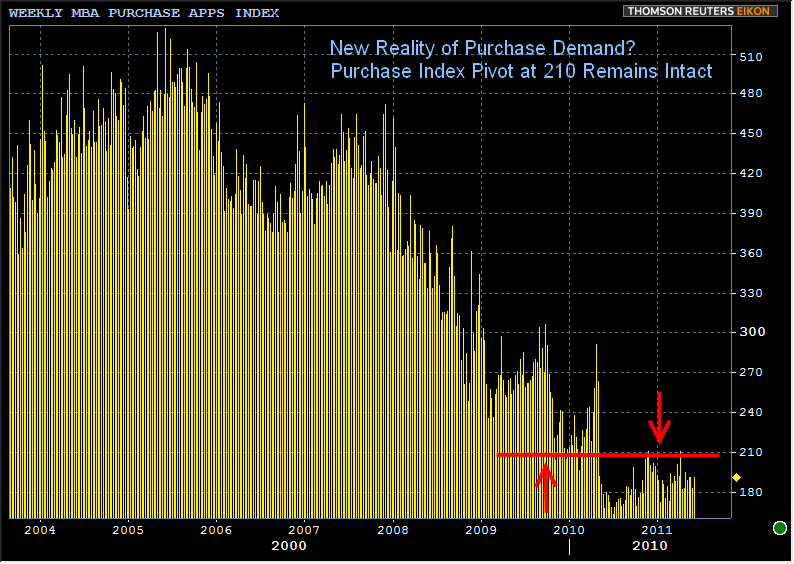The Mortgage Bankers Association (MBA) today released its Weekly Mortgage Applications Survey* for the week ending June 7, 2011.
The Refinance Index ticked up noticeably in the last week, from 2475 to 2883, the highest reading since November 2010. This is bittersweet as it finally showed some linear connection between falling rates and refi demand...only to have rates rise this week. Even so, the last time rates fell from 5.0 to 4.5 as they have in 2011, readings around 3000 on the refi index represented the LOW END, moving over 5000 on the index by the time rates hit the same reported level as they did last week.

Plain and Simple: The same historically low rates are producing only a little more than half the refi demand as last fall, providing a stark picture of the current lending environment.
The Purchase Index was fairly uneventful last week. Although it rose from 182.9 to 191.1, that puts it right in line with a majority of previous weeks. In fact, 2 out of every 3 weeks since March have been within 5 points of 190. Pretty darn stagnant. With the exception of the horrible levels under 170 in the summer of 2010, we're sideways at the lowest levels in the history of MBA's reporting with a clear pivot point around 210 separating past and present.

Excerpts from the Release...
The Market Composite Index, a measure of mortgage loan application volume, increased 13.0 percent on a seasonally adjusted basis from one week earlier. On an unadjusted basis, the Index increased 24.5 percent compared with the previous week, which included Memorial Day. The Refinance Index increased 16.5 percent from the previous week. The seasonally adjusted Purchase Index increased 4.5 percent from one week earlier. The unadjusted Purchase Index increased 14.2 percent compared with the previous week and was 6.1 percent higher than the same week one year ago.
"Mortgage rates have declined for 8 of the past 9 weeks. Coming off of the Memorial Day holiday, refinance application volume increased significantly, as borrowers jumped to lock in the lowest mortgage rates since last November," said Michael Fratantoni, MBA's Vice President of Research and Economics. "The volume of refinance applications still remains 28 percent below levels seen at that time, as borrowers with an incentive to refinance remain constrained from doing so by lack of equity in their homes."
The four week moving average for the seasonally adjusted Market Index is up 2.4 percent. The four week moving average is up 0.3 percent for the seasonally adjusted Purchase Index, while this average is up 3.1 percent for the Refinance Index.
The refinance share of mortgage activity increased to 70.0 percent of total applications from 67.3 percent the previous week. This is the highest refinance share since January 21, 2011. The adjustable-rate mortgage (ARM) share of activity remained unchanged at 6.1 percent of total applications from the previous week.
The average contract interest rate for 30-year fixed-rate mortgages decreased to 4.51 percent from 4.54 percent, with points increasing to 1.05 from 0.94 (including the origination fee) for 80 percent loan-to-value (LTV) ratio loans. This is the lowest 30-year average rate since November 19, 2010. The effective rate also decreased from last week.
The average contract interest rate for 15-year fixed-rate mortgages remained unchanged at 3.67 percent, while points also remained unchanged at 1.06 (including the origination fee) for 80 percent LTV loans. This is the lowest 15-year average contract rate since November 5, 2010. The effective rate increased from last week.
*The MBA's loan application survey covers over 50% of all U.S. residential mortgage loan applications taken by mortgage bankers, commercial banks, and thrifts. The data gives economists a snapshot view of consumer demand for mortgage loans. In a falling mortgage rate environment, a trend of increasing refinance applications implies consumers are seeking out lower monthly payments. If consumers are able to reduce their monthly mortgage payment and increase disposable income through refinancing, it can be a positive for the economy as a whole (may boost consumer spending. It also allows debtors to pay down personal liabilities faster. A trend of declining purchase applications implies home buyer demand is shrinking.







